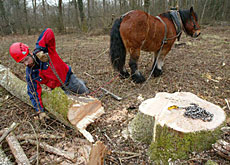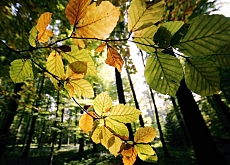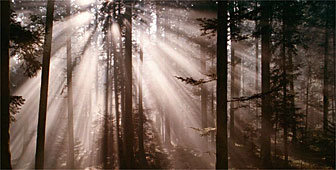Timber trade lays strong roots for the future

Demand for Swiss timber is increasing, pulling the industry out of the red and a decade of crises.
The recent upturn has underlined the importance of Switzerland’s multipurpose forests. But even though they are expanding, they are under-exploited.
“There has definitely been a marked interest in the use of wood for energy and construction purposes,” confirmed Markus Moser, director of the French-Swiss branch of Lignum, the Swiss timber umbrella organisation.
Moser is convinced that high oil prices have had an impact on people’s buying habits. “Our forests are full of wood; there is great potential and Swiss wood is competitive,” he said.
“But international competition is tough. Margins are slim and Switzerland’s long-standing ecological tradition complicates matters. It’s almost impossible for us to rival the northern countries where huge areas are forested.”
Even so, large sums of money are being invested in the Swiss forestry sector, especially the processing industry, with huge new projects such as the Domat/Ems (Graubünden) and Luterbach (Solothurn) saw mills.
The industry hopes to soon be back on its feet.
“The major restructuring efforts are now starting to bear fruit,” said Elisabeth Graf Pannatier, an expert from the Federal Institute for Forest, Snow and Landscape Research who has recently published a book entitled “The future of Swiss forests”.
In her book, Graf explains how the financial gap between Swiss forestry enterprises’ costs and revenues grew ever wider from the end of the 1980s.
The reduction in the price of wood, high operating costs, ever-smaller properties and difficult topography as well as more administrative work and reduced subsidies following budget cuts were to blame. And the Vivian (1990) and Lothar (1999) hurricanes, the 2003 drought and the spread of the bark beetle have been equally damaging.
Multipurpose
“Switzerland is a small country where the forests fulfil several simultaneous roles and functions,” said Graf Pannatier.
“Since the 1960s we have been more demanding of our forests,” added Christian Küchli from the forest and timber division of the Federal Environment Office.
“[They must] protect against natural hazards, such as soil erosion, avalanches or rock falls,” he said. “[People also expect to use them for] recreation and leisure, and they are also needed for filtering drinking water. And then there is their role to conserve biodiversity or reduce carbon dioxide that is present in the atmosphere.”
But Küchli is cautious about the current health of Swiss forests. There is a growing risk of nitrogen in the air seeping into the ground and ending up in the groundwater tables, he warned.
Under-exploited
According to the Federal Statistics Office and the Environment Office, in 2001 the overall added value of the forestry economy and timber industry was worth around SFr7.6 billion ($6.05 billion), or 1.8 per cent of gross domestic product (GDP).
But even though forests are expanding, they remain under-exploited (5.2 million square hectares of wood collected in 2005 out of a potential eight million square hectares) and the balance of activity is still negative.
In 2004 Switzerland exported SFr3.75 billion worth of wood, but imported SFr5.98 billion.
swissinfo, Mathias Froidevaux
Swiss forests cover 1.2 million square hectares, or 30% of the country.
Each year they extend by 50 square kilometres or 1.5 metres per second, especially in the Alps, foothills and Italian-speaking region.
Roughly three-quarters of the forests (73%) are public and the remainder (27%) are private.
The forestry and timber industries employ around 7,300 and 72,000 people, respectively.
The first Swiss forestry laws date back to 1876 and 1902. The 1991 law, which entered into force in 1993, is a framework that outlines the main principles that the cantons are responsible for implementing.
At the 1992 Rio Summit, Switzerland committed to the sustainability of its forests.
In October 2005 interest groups put forward a people’s initiative to better protect Swiss forests.
In 2007 the government plans to revise part of the 1991 law to strengthen the forestry services and economy.

In compliance with the JTI standards
More: SWI swissinfo.ch certified by the Journalism Trust Initiative


You can find an overview of ongoing debates with our journalists here. Please join us!
If you want to start a conversation about a topic raised in this article or want to report factual errors, email us at english@swissinfo.ch.